Like many people I have to admit that I had never heard of the beautiful Rosslyn Chapel until I read Dan Brown’s ‘The Da Vinci Code’.
Margaret and I paid a visit to the Chapel in April 2010. We had a planned trip to Portugal cancelled at the last-minute due to the infamous Icelandic ash cloud, so we set off in the car on an impromptu trip visiting old friends and tourist sites all across northern England and southern Scotland and Rosslyn Chapel was one of many historic sites we stopped at.
Unfortunately then the Chapel was undergoing a much-needed renovation and Margaret said ‘we must come back when all this scaffolding comes down’ – so this year we did.
Dan Brown falsely claims that the names Roslin/Rosslyn originate because the Chapel sits on the ancient Paris Meridian, a French alternative to The Greenwich Meridian (which it doesn’t), which he names ‘the Rose Line’ and then (again falsely) associates it with the Rosicrucians and the supposed bloodline of Mary Magdalene.

The Chapel is situated on a rise above the town of Roslin. Behind is a wooded gully and even in mid-November many of the trees were still sporting their autumnal colours.
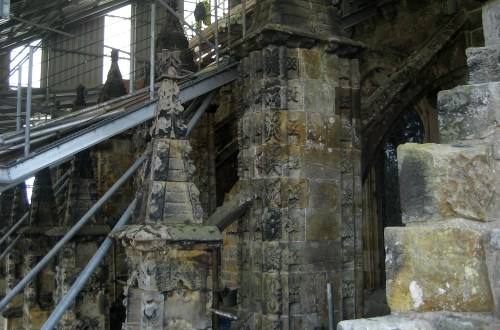
This is what the exterior of the Chapel looked like when we visited in 2010, there was also scaffolding inside the Chapel.
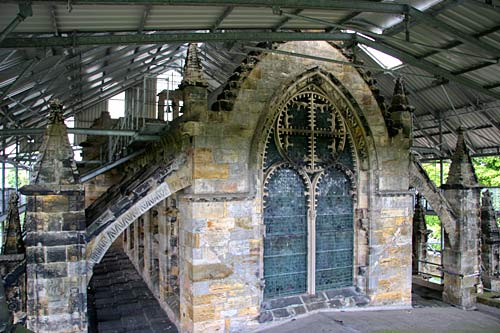
Here is an elevated view (taken from Wikipedia) of the chapel during the restoration process.

This is what the Rosslyn Chapel looks like today. Much of my information on the history of the chapel has been taken from Wikipedia or https://www.rosslynchapel.com/about/rosslyn-chapel-timeline/

The Rosslyn Chapel was commissioned in 1446 by William St Clair (the family now know as Sinclair). It is thought that it might have been planned as part of a much larger building, but work ceased after William’s death in 1484. The endowments for Rosslyn Chapel were seized as the effects of the Reformation began (this was the time of Henry VIII’s dissolution of the monasteries). The Chapel’s provost and prebendaries were forced to resign as a result and in 1592 Oliver St Clair was ordered to destroy the altars of Rosslyn, it being described as a ‘house and monument of idolatrie’. After the altars were destroyed, the Chapel ceased to be used as a house of prayer and subsequently fell into disrepair.
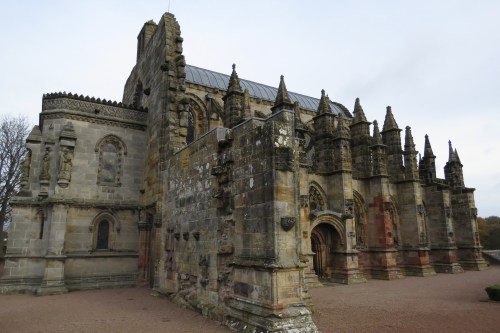
In 1630 (another!) William St Clair was pronounced Grand Master of the Masons in Scotland. In 1650 Oliver Cromwell’s troops sack Rosslyn Castle. The Chapel was spared, although it was used for stabling the troop’s horses. In the same year, Sir William Sinclair of Rosslyn died at the Battle of Dunbar. He is believed to be the last knight buried in full armour in the vault below the Chapel, said to be the family custom. The chapel falls into serious disrepair for 150 years until limited restoration occurred in 1736. Between 1780 and 1850 visits by the likes of Robbie Burns, Dorothy Wordsworth and Queen Victoria brought the chapel to the nation’s attention as a place of romantic association and mystery, something that was enhanced by the enigmatic nature of the carvings. In the 1950s a major restoration was carried out but cladding the stonework with a concrete like material (which gave the interior its current grey colouration) but it sealed the moisture in and the chapel continued to deteriorate badly. It’s inclusion in the 2003 novel ‘The Da Vinci Code’ and the 2006 film brought worldwide attention and visitor numbers increased ten-fold. This along with a £4.9m lottery grant has allowed a full-scale restoration.
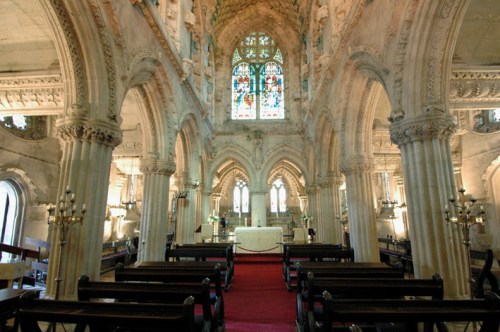
Photography inside the Chapel is no longer allowed. This and the following photos have been taken from the internet either from the Rosslyn Chapel website or via Wikipedia. Those photos that were credited were taken by either ‘Guinnog’, J McInnis, Joe Ellis, Jeremy Atherton or ‘the Lothians’. Although this photo makes it look quite spacious the chapel is quite small inside ….

…. but is very high. Of course the stained glass windows are a later addition.

A wide angle view of the fantastically ornate roof.

The chapel is covered in ornate carvings, many of which would have had deep meaning at the time when the chapel was built. Of note are the many ‘Green Men’, about 100 carvings of a pagan symbol of fertility and regrowth that seems curiously out-of-place in a Christian place of worship.

This image of the fallen angel Lucifer bound by ropes is said to be a motif of the Masons. Both the Masons and Knight’s Templar are said to have historic associations with Rosslyn. Legends associated with the chapel include that it is the final resting place of the head of John the Baptist or that of the Holy Grail.

The chapel was commissioned in 1446, building started in 1456 and ended in 1484, so how then were maize and aloe vera (North American plants that supposedly couldn’t have been discovered by Europeans until after Columbus’ voyage in 1492) depicted in the carvings? I don’t believe any of the superstitions associated with Rosslyn but I do believe that Columbus wasn’t the first European to land in the New World!

Many embossed carvings are to be found, some depicting scenes from the Bible, others life after death and still others whose meaning is greatly debated by both scholars and by those with a ‘mystical orientation’.

…. these include the 213 cubes carved into buttresses and architraves that have a variable number of dots on them. Some have interpreted this as a secret code, others as a musical score.
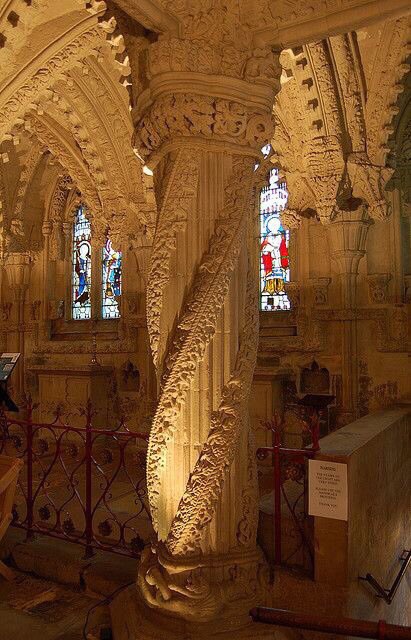
Perhaps the most spectacular carvings are to be found on the so-called Apprentice Pillar. The following is taken from Wikipedia: ‘One of the more notable architectural features of the Chapel is the “Apprentice Pillar. Originally called the “Prince’s Pillar” (in the 1778 document An Account of the Chapel of Roslin) the name morphed over time due to a legend dating from the 18th century, involving the master mason in charge of the stonework in the chapel and his young apprentice mason. According to the legend, the master mason did not believe that the apprentice could perform the complicated task of carving the column without seeing the original which formed the inspiration for the design. The master mason travelled to see the original himself, but upon his return was enraged to find that the upstart apprentice had completed the column by himself. In a fit of jealous anger, the master mason took his mallet and struck the apprentice on the head, killing him. The legend concludes that as punishment for his crime, the master mason’s face was carved into the opposite corner to forever gaze upon his apprentice’s pillar. On the architrave joining the pillar there is an inscription, Forte est vinum fortior est rex fortiores sunt mulieres super omnia vincit veritas: “Wine is strong, a king is stronger, women are stronger still, but truth conquers all”. The author Henning Klovekorn has proposed that the pillar is representative of one of the roots of the Nordic Yggdrasil tree, prominent in Germanic and Norse mythology. He compares the dragons at the base of the pillar to the dragons found eating away at the base of the Yggdrasil root and, pointing out that at the top of the pillar is carved tree foliage, argues that the Nordic/Viking association is plausible considering the many auxiliary references in the chapel to Celtic and Norse mythology. There are those who claim the Holy Grail is buried under the Apprentice’s Pillar! Of course I don’t believe any of these fairy tales but its fun relating them!

As I said before, although not know so widely before the publication of The Da Vinci Code, the chapel has always been a source of mysticism and wonder, as a drawing from ‘Heath’s Picturesque Manual’ from 1835 shows. Here on the left the Mason’s Pillar and the far superior Apprentice’s Pillar can be seen.

Near the chapel is Rosslyn Castle once the home of the Saint Clair family.

The castle dates from the late 14th or early 15th century and so predates the chapel. The castle suffered from a domestic fire and attacks in the ‘War of Rough Wooing’ in 1544, and by Cromwell’s troops in the Civil War.

The castle once contained a scriptorium containing many valuable documents some of which (including the earliest example of Scots prose) are in the National Library of Scotland. In a fire in 1452 valuable documents were said to have been lowered from the castle by a rope. Questions of the nature and current whereabouts of these documents adds to the mystery surrounding the Rosslyn (Roslin) area.
Needing to be in Aberdeen that evening we had to leave by late morning. We crossed the Firth of Forth and did some birding/sightseeing along the Fife coast. This and more will be the subject of the next post.